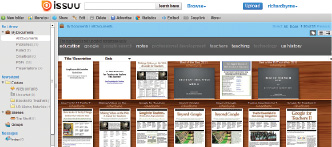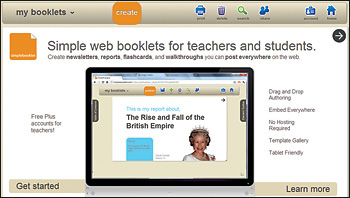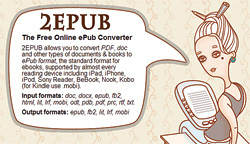Technology has changed what it means to be an author and how people can discover your work. Today, anyone with a computer and Internet access can create an ebook, which is great news for schools. Now teachers and students can build their own reference works, and young authors can publish their stories and share them with the world.
 Following are tools that you can use with your students to create ebooks. With them, you can exercise a range of capabilities, from adding a few page-turning effects to PDFs to creating full-blown interactive ebooks with multimedia elements.
Following are tools that you can use with your students to create ebooks. With them, you can exercise a range of capabilities, from adding a few page-turning effects to PDFs to creating full-blown interactive ebooks with multimedia elements.
The simplest form of an ebook is a PDF or Word document that’s been enhanced with some basic page-turning effects and displayed online. Any word-processing program can be used to create the document. Then, to add page-turning effects for online display, upload the completed document to a service like Issuu or Yudu. Both are free services where you can upload PDF, Word, Excel, and Powerpoint files to create online magazines. The page-turning effect and zoom options are built into Issuu and Yudu and automatically activated. After your page-turning document is live on either service, you can embed it into a blog, wiki, or website. Issuu offers a “bookshelf” widget, which you can also embed to display previews of multiple documents. The widget is ideal for teachers who want to display the work of an entire class in one neat package on a classroom blog.
 An excellent tool for creating multimedia ebooks, Simple Booklet lets student authors combine text, images, videos, and audio files. Creating a multimedia ebook on Simple Booklet is a great way for students to collate and publish information about a research topic. Students could also use the tool to add audio and video elements to their short stories. Simple Booklet comes in commercial and education versions. The education option offers the benefits of the commercial features without cost to teachers.
An excellent tool for creating multimedia ebooks, Simple Booklet lets student authors combine text, images, videos, and audio files. Creating a multimedia ebook on Simple Booklet is a great way for students to collate and publish information about a research topic. Students could also use the tool to add audio and video elements to their short stories. Simple Booklet comes in commercial and education versions. The education option offers the benefits of the commercial features without cost to teachers.
To get started with Simple Booklet, sign up for a free account and click create. Select the layout template that suits your needs. To add content, click anywhere on the blank canvas and a menu of options will appear. You can add text, images, audio files, videos, and links to your booklet, and each page can contain multiple elements. Upload your own video clips or select from a variety of providers, including SchoolTube, TeacherTube, and YouTube. To add audio to your pages, you can similarly use your own sound or select from the online hosts Last.fm, Sound Cloud, or Mix Cloud. When you’re done building pages in your ebook, you can share it online by embedding it into a webpage or provide the unique link generated for your booklet.
 Mobi and ePub are the file formats used for publishing ebooks on Kindles and iPads respectively. 2EPUB is an excellent free tool that enables users to convert PDFs, Word documents, and files in RTF, Text, ODT, and HTML format into ePub and Mobi. To use 2EPUB, simply upload your file, select your desired output format (ePub or Mobi), then download the conversion. Registration is not required to use 2EPUB.
Mobi and ePub are the file formats used for publishing ebooks on Kindles and iPads respectively. 2EPUB is an excellent free tool that enables users to convert PDFs, Word documents, and files in RTF, Text, ODT, and HTML format into ePub and Mobi. To use 2EPUB, simply upload your file, select your desired output format (ePub or Mobi), then download the conversion. Registration is not required to use 2EPUB.
Free service dotEPUB allows you to convert the contents of a webpage into ePub or Mobi format to read on your device. If your students are building digital portfolios on a wiki, blog, or website service, tap dotEPUB to quickly convert that content into an ebook. I’ve had classes use a wiki, for example, to build reference pages about topics in U.S. history. With dotEPUB, you can turn each of those pages into digital files that students can read and study on their iPads, Kindles, or other devices.
So give these tools a try. Who knows? You could have the next great American novel or reference work just waiting to break out from your classroom or library.



WRT dotEPUB, be aware that there is a limit (and fairly small, IIRC) to the number of images it will capture from a site and include in your ebook. I’m guessing it’s necessary to prevent too much traffic or volume on the dotEPUB server. With the limit as small as it is, I find it unacceptable for producing anything but mainly text-based epubs.
Thanks for sharing those lovly Ebook toolkit. To be frank, I am a user of both “axmag” and issuu”, they worked awesome too. But freeware always has some limit. I am going to pay for some professional multimedia ebook creator like Kvisoft Flipbook Maker PRO. Do you guys has any ideas about tools at same price and quality?